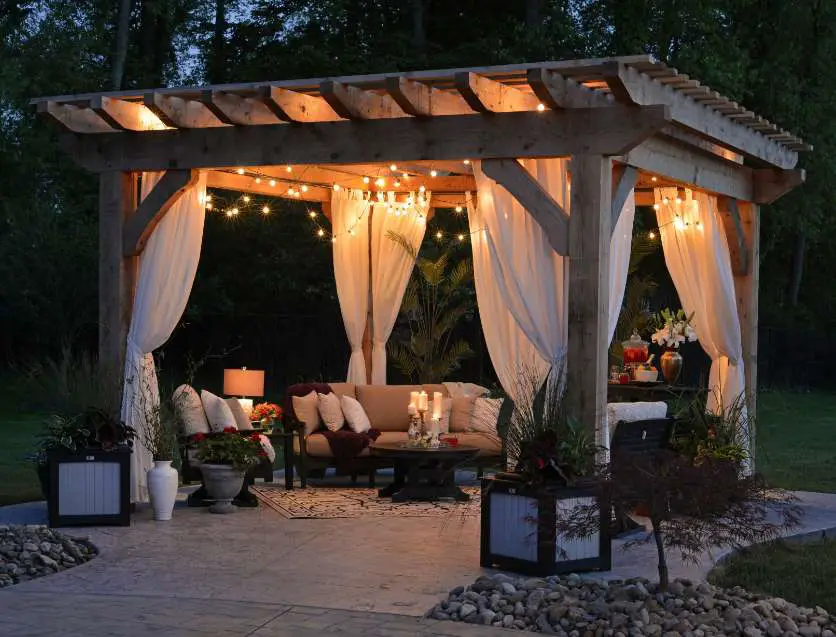Yes, a permit is usually required to build a pergola attached to your house. Building a pergola attached to your house can be a great addition to your outdoor space.
It provides shade and a cozy spot to relax or entertain guests. However, before you start construction, it’s important to understand the permit requirements. In most cases, you will need a permit to build a pergola attached to your house.
This is because it involves altering the structure of your home, which may impact safety and zoning regulations. Obtaining a permit ensures that the construction meets the necessary standards and complies with local building codes. Ignoring the permit requirement can result in costly fines or even having to dismantle the pergola. Therefore, it’s best to check with your local building department to determine the specific requirements and process for obtaining a permit for your pergola project.

Credit: azenco-outdoor.com
Understanding The Permit Basics
Building a pergola attached to your house may or may not require a permit, depending on various factors. Understanding the basics of permits is essential. It is important to differentiate between a pergola and a deck, as they have different permit requirements.
Building permits are typically required for structures that alter the footprint of your property. Factors such as size, height, and location of the pergola can influence the permit requirement. Local building codes and zoning regulations also play a role in determining if a permit is necessary.
Consulting with your local building department or a professional contractor can help you determine if you need a permit. It is recommended to ensure compliance with all regulations to avoid legal and financial complications in the future.
Navigating The Regulation Maze
Navigating the regulation maze of building a pergola attached to your house involves several essential steps. First, research your city’s requirements to ensure compliance. Check for any zoning or hoa restrictions that may impact your project. Next, determine the size and type of pergola you want to build, taking into consideration height and square footage limitations.
Finally, explore the pros and cons of attached versus free-standing pergolas to make an informed decision. By following these steps, you can ensure that your pergola project is in compliance with local building codes and regulations.
Evaluating The Need For A Permit
Building a pergola attached to your house may or may not require a permit. Examining the construction specifics, materials, and structural considerations is crucial. Safety and structural integrity must also be taken into account. It’s important to assess potential permit exemptions based on the size and design criteria of your pergola.
Keep in mind that temporary structures may have different timeframes compared to permanent ones. Following these guidelines will help you evaluate whether or not you need a permit for your pergola project.
The Permit Application Process
Building a pergola attached to your house may require a permit, depending on local regulations. The permit application process involves several steps. Firstly, gather the necessary documents and information. This includes blueprint and design plans, as well as cost estimation and contractor details.
Once you have all the required materials, submit the permit application. You can usually choose to apply online or in-person, depending on the options available in your area. Don’t forget to pay the required fees and take note of the expected timelines.
Following these steps will ensure that you comply with all necessary regulations and can proceed with your pergola construction without any issues.
The Ins And Outs Of Permit Approval
When planning to build a pergola attached to your house, it’s crucial to understand the permit approval process. First, your plans will undergo a thorough review, and inspections may be required. Be prepared to address potential modifications or rejections along the way.
Compliance with building codes is essential to ensure the project meets safety standards. Adhering to these regulations also involves implementing necessary safety measures. Finally, it is highly recommended to hire a professional installation service to guarantee a successful and compliant project.
By following these guidelines, you can confidently navigate the permit approval process for building a pergola attached to your house.
Frequently Asked Questions For Do I Need A Permit To Build A Pergola Attached To The House
Do I Need A Permit To Build A Pergola Attached To The House?
Yes, in most cases, you will need a permit to build a pergola attached to your house. The requirements for permits may vary based on your location and the size of the pergola. It’s important to check with your local building department to ensure compliance with regulations.
What Are The Benefits Of Obtaining A Permit For A Pergola?
Obtaining a permit for your pergola ensures that your structure meets safety standards and building codes. It also protects you from potential legal issues and penalties in case of non-compliance. Additionally, it may increase the value of your home when it comes time to sell.
How Can I Find Out If I Need A Permit For My Pergola?
To determine if you need a permit for your pergola, contact your local building department or visit their website. They will provide you with specific requirements for your area, including information about permits, inspections, and any associated fees. It’s always better to be safe and check with the authorities.
Are There Any Instances Where A Permit May Not Be Required?
In some cases, a permit may not be required for smaller pergolas or those that are not attached to the house. However, this can vary depending on your local building codes and regulations. It’s always recommended to check with your local authorities to ensure compliance with the rules.
What Happens If I Build A Pergola Without A Permit?
Building a pergola without a permit can have consequences, such as fines, legal issues, and being required to remove the structure. It’s not worth the risk, as non-compliance can lead to more hassle and expense in the long run. Always follow the necessary procedures to avoid any problems.
How Long Does It Typically Take To Obtain A Permit For A Pergola?
The time it takes to obtain a permit for a pergola can vary depending on your location and the workload of your local building department. It’s advisable to apply for the permit well in advance of your desired construction start date to allow for any potential delays.
Conclusion
Obtaining the necessary permits for building a pergola attached to your house is essential to ensure compliance with local building codes and regulations. While requirements may vary depending on your location, it is crucial to check with your local municipality or building department before starting any construction project.
Failure to obtain the required permits can result in costly fines and potential legal issues. Aside from legal compliance, obtaining permits also ensures the safety and structural integrity of your pergola. The permit process typically involves submitting plans and specifications for review by building officials.
This ensures that your pergola meets necessary structural requirements and takes into account factors such as wind resistance and load-bearing capabilities. Ultimately, the decision to obtain a permit for your pergola construction is in your best interest. It not only ensures compliance with local regulations but also guarantees the safety and longevity of your pergola.
So, before you embark on your pergola-building journey, don’t forget to check the permit requirements in your area and get the necessary approvals. Happy pergola building!

